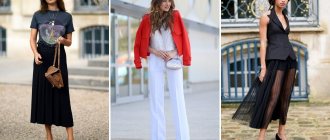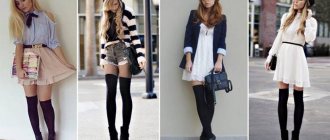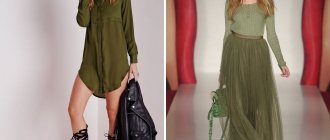Clothing in the Gothic style causes mixed reactions, from complete rejection to genuine interest and admiration. Dark personalities with an impenetrable expression of a deathly pale face, like aliens from the other world or a parallel world, attract the eye, make you turn around with caution or with the thought “damn beautiful, but it won’t suit me.” These are goths. Whether it is necessary to belong to their subculture in order to dress in such a style is a moot point. Now let’s try, without changing our worldview, to join the shocking gothic fashion and add an extravagant touch to your everyday look or for special occasions.
In this article:
- a brief excursion into history;
- style features;
- variations on a theme;
- selection of accessories;
- makeup accents;
- who will suit it;
- famous goth personalities.
Let’s briefly go through history from the Middle Ages to the present day and begin to study photos, select clothes and create the image of a charming goth or change our attitude towards this culture to a more loyal one. After all, its representatives are ordinary people who express their individuality in this way.
The history of Gothic fashion
Gloomy morals reigned in Europe in the 12th-15th centuries. It was an eerie and at the same time romantic time from the point of view of a modern person. The omnipotence of the Catholic Church, the merciless bonfires of the Inquisition, burning witches, noble knights ready to sacrifice their lives for the sake of beautiful ladies.
It was during this era that a majestic style, mesmerizing with cold inaccessibility, was born, called Gothic, that is, barbaric, denying the classical canons of beauty, proportions and harmony. At first, the direction of architecture, and then clothing, with pronounced sharp angles, symbolized the desire upward, towards God, the denial of the earthly importance of existence.
The new style became most widespread in France. The clothes of Parisian fashionistas were pretentious and original:
- pointed hats and pointed shoes;
- thin silhouettes covered with corsets;
- trains of infinite length;
- jagged, uneven edges of sleeves and hems;
- an abundance of bright ornaments and floral motifs.
Tailoring from a simple craft turned into an art, and all cutting techniques known to this day were invented.
And then the world stepped into the Renaissance, and Gothic sank into oblivion. The attempt to emerge from oblivion at the end of the 18th and beginning of the 19th centuries was short-lived and unsuccessful. In the 70s of the 20th century, gothic revived again, replacing the fading punk culture, which failed to establish itself in its slogan “Live fast - die young.”
Life was more or less clear, and almost everyone could cope. But the theme of death, the afterlife, and eternal mourning appealed to the taste of gloomy romantics. Their favorite color became black, and cemeteries became their favorite places to walk and gather. The new gothic style finally took shape by the 80s, and in the 2000s it appeared on the catwalks.
Cloth
Appearance - clothes and shoes, hairstyles, paraphernalia - is one of the most important components of the Gothic subculture and can be of paramount importance in the eyes of its bearers. Abroad, the term “mall goth” has even arisen, which mockingly refers to those who purchase the most affordable and not always “truly gothic” items of clothing in regular stores, rather than ordering them from designers; in fact (due to the high cost and complexity of such orders), even the most picky Goths cannot afford to dress entirely from designers.
The trendsetters of gothic fashion were musicians whose appearance their fans were guided by. At the early stage of the development of the gothic subculture, certain elements of the punk image were typical for its representatives - from this movement the goths borrowed piercings, hairstyles in the form of high “spikes” and mohawks. Gothic fashion The 1980s was much more extreme and shocking than can be seen now, and developed on the basis of the “do it yourself” principle - its fans sewed their own clothes and made jewelry from scrap materials, and items purchased in stores were most often either remade or “modified” in every possible way: torn, decorated with stripes and safety pins
Clothing can be either emphatically tight, tightly fitting the figure, or quite loose or even open. As for footwear, high, pointed leather boots (for women - usually with a thin stiletto heel), heavy boots (sometimes of the army type, often on a high platform) are common. Women. very often they wear corsets made of various materials - velvet, brocade, vinyl, leather, latex; a men's suit most often consists of trousers and a shirt, and their appearance depends on the specific style direction to which the goth belongs.
Some representatives of the subculture prefer clothes stylized in the fashion of the 18th-19th centuries (the so-called “Victorian Goths”, English Victorian Goths, and “Romantic Goths”, English Romantigoths). Women who adhere to this style usually wear long dresses, corsets, lace veils, long gloves, decorative umbrellas, while men wear tailcoats and top hats or “romantic” blouses. The formation of a typically Gothic female image was largely influenced by the image of the “femme fatale,” which originated as early as in the Victorian era and popularized by film noir
The “vampire” type of appearance, partly similar to the “Victorian” one, is also widely popular. Many women choose a style inspired by the images of Morticia Addams, Vampira and Elvira. For men who adhere to this trend, examples are charismatic vampire characters, for example, Lestat de Lioncourt. Representatives of this style, as a rule, wear ankhs.
Among some Goths, Western aesthetics are popular—cowboy hats, leather vests and fringed pants, and boots. It came into fashion thanks to the bands Fields of the Nephilim and The Cult, who used a similar image to create the image of romantic loners, daring outcast rebels. The wide-brimmed hat was also worn by Andrew Eldritch from Sisters of Mercy to shade his face.. Fans of Western goths join gothabilly, whose clothing style can vary, but is most often based on an ironic reinterpretation of retro aesthetics. The formation of the female image among representatives of this movement was greatly influenced by the famous pin-up model Bettie Page...
Gothic fashion can be closer to the clothing styles of other trends - for example, rivetheads or fans of metal music: goths also often wear leather clothes, chains and metal accessories. Sometimes sadomasochistic attributes are used, for example, collars - these elements first appeared in the image of Susie Sue and were intended to emphasize her image of a “vampire woman”[88]. Latex clothing is no less popular among goths than among rivetheads and BDSM lovers, since fetish fashion has become widespread in gothic fashion since the early 1990s and specialized fetish clothing stores like Demask have appeared
Today, the gothic and fetish subcultures have become closer and have become so friendly that representatives of the latter often hold their events in gothic clubs. Gothic fashion influenced the developing steampunk subculture, the aesthetics of which are in many ways close to representatives of the “Victorian” and “romantic” movements; According to sociologist and literary critic Michael Du Plessis, all steampunk fashion is basically based on Gothic fashion, except that instead of black it uses brown more often.
In the 1990s, a kind of “subculture within a subculture” arose - cyber-goths, whose fashion is something between gothic and industrial, emerged as a separate style direction. Representatives of this style use bright “acid” colors in their clothes, prefer clothes made from non-natural fabrics, wear high platform boots, and often use elements of cyberpunk aesthetics. Many cyber goths wear dreadlocks.
cybergoths
There are also more eccentric styles of clothing - for example, “fairy goths” are sometimes identified as a separate trend, striving to resemble the classic fairies from Celtic folklore and dressing accordingly, even using artificial “wings.” In Japan, gothic style is partly mixed with the local Visual kei subculture , which gave rise to such a clothing style as “Gothic Lolita”. As a rule, “lolitas” wear Victorian-style knee-length dresses with frills and crinolines, hats, decorative umbrellas and platform shoes with rounded toes; there are many brands of clothing designed specifically for representatives of this style, which is gradually becoming popular in the West
Currently, many representatives of the subculture do not maintain the image constantly, but dress in the Gothic style only when they go to concerts or other themed events - they are sometimes ironically called “Tuesday Goths”; on Tuesdays, some nightclubs hold gothic parties).Nevertheless, even in cases where the goths cannot afford to constantly maintain the chosen style, they try to preserve at least its individual elements in their appearance. Goths working in establishments with strict dress control may use a “corporate” style with a minimum of jewelry and makeup (the so-called “Corporate Slave Goths”). Attitudes towards such representatives of the subculture within their communities may vary, but they are usually perceived normally, without prejudice.
It is interesting to note that at the present stage, Gothic fashion can influence “high” fashion and even compete with it. Some famous couturiers, for example, John Galliano Alexander McQueen, Jean-Paul Gaultier and Yohji Yamamoto, at different times created collections clearly inspired by classical gothic image, and fashion designer Rick Owens openly admitted that he sympathized with the subculture and experienced it
Modern ready-to-wear style: characteristic features, distinctive features
The Middle Ages left its mark on the appearance of melancholy fatalists. But they adopted only a narrow, laced waist; otherwise, the fashion trends of that time have little in common with the appearance of modern Goths.
These grotesque personalities rather took on the role of a victim of the Inquisition, who appeared in our world with a reminder of eternal sorrow, mourning, and the frailty of existence. But believe me, deep down, none of them are going to die, and the exquisite beauty of death is a way to present oneself to the world and be noticed.
If you want to accurately identify representatives of this subculture in a crowd or try on clothes in the Gothic style, remember the main features:
- predominance of black with contrasting accents - white, red;
- dark rich colors are allowed - purple, burgundy, green, blue;
- clear silhouettes, straight flying lines;
- frank extravagance with subtext for adults;
- vintage or ultra-modern dresses with a complex cut;
- voluminous skirts, mini or maxi length;
- frill, lace, mesh, lacing;
- corsets and belts, mainly over clothing;
- loose black blouses, T-shirts, shirts, turtlenecks;
- an abundance of leather - trousers, skirts, leather jackets;
- rough shoes with platforms or high heels (grinders, camelots, ankle boots);
- eccentric umbrellas, veiled hats, long gloves;
- massive white metal jewelry;
- expressive contrast of dark hair and completely white face;
- deliberately careless aggressive makeup in black and blood-red tones.
Preferable fabrics:
- velvet;
- atlas;
- silk;
- leather;
- vinyl;
- brocade;
- taffeta;
- lace;
- organza.
The Goths have a fair share of aristocracy in both women's style and men's clothing. Long black coats and raincoats, a top-hat, and on special occasions a tailcoat, what a London dandy. But still, the image of a modern goth girl deserves more attention.
Modern Gothic style of clothing
Its features are:
Options for self-expression in clothes from the goths
The image of a Gothic Lolita can be an interesting discovery for girls. This style is one of the types of Japanese street fashion. It does not contain any hints of vulgarity and vulgarity, but on the contrary looks quite elegant and relaxed. Character traits:
- black color actively diluted with blue, blue, red details;
- quite a lot of white - stockings, gloves, petticoats;
- formal dresses with bodices and full skirts;
- flirtatiously peeking shirt collars and lace pantaloons;
- elegant knee length;
- gothic prints;
- elegant hats with ribbons, coffin handbags;
- shoes with massive heels or very high (up to 20 cm) platforms;
- gloomy makeup can be replaced with makeup that focuses on the eyes;
- hair - black curls or straight dark red, purple or red strands are possible in black hair.
The result is a completely charming, feminine image. But the Gothic clothing style is very diverse. There are other directions as well.
- The cyber-gloomy palette is generously complemented by acidic shades, hairstyles – mohawks, dreadlocks, makeup in neon tones.
- Jay is an imitation of the heroes of Japanese anime, but with strict adherence to the Gothic rules - dark clothes and contrasting makeup.
- Medieval - the most romantic branch of the Goth subculture: indispensable corsets, Victorian-style dresses, long gloves, lace, hats.
- Vampire is the most popular style. The emphasis is on the obligatory presence of a rich red color, symbolizing blood and impeccable whiteness of the skin.
- Corporate – allows you to comply with the dress code in a work environment. Usually it is a strict black suit with a snow-white shirt and some jewelry in the appropriate style.
As you can see, putting together a set of clothes in a modern gothic style, suitable for any setting, is not difficult. But that's not all. It is important to maintain the harmony of the image as a whole, that is, to turn into a Goth or Hotness from head to toe.
Varieties of Gothic style
Gothic fashion is usually divided into the following main trends:
- androgynous gothic;
- antique (classical, Victorian, romantic);
- vampire;
- Western Gothic;
- J-Gothic (“Gothic Lolita”);
- gypsy gothic;
- cyber gothic;
- corporate gothic;
- steampunk gothic;
- Tribal Gothic;
- fairy gothic;
- fetish gothic.
And each of these areas has its own “tricks”.
Techniques for creating an image in different Gothic groups
Antique Goths
Antique, classic Goths are focused on the English costume that was in use since the end of the 18th century. And this is a very wide range: frock coats, camisoles, tailcoats and three-piece suits, robes, skirts with frames, corsets, garters, top hats, veils... But this is not enough, the image of a classic Goth requires reinforcement with many romantic and aristocratic details: lace collars, coattails, draperies, lush cuffs, lacing, gloves, openwork umbrellas.
Androgynous goths dress in such a way as to create the impression of a sexless, “otherworldly” creature. If you are ready for such transformations, then first of all you need a wide cloak, a cape with a chaperon or a mantle, the folds of which will hide your figure.
Vampire Goths
Vampire goths exploit the theme of ghouls and werewolves. Representatives of this gothic group imitate characters from film stories about Dracula and other ghouls. If you are one of the fans of vampire sagas and zombie thrillers, then keep in mind that you should rely on a combination of coal-black and ominous scarlet colors.
Western Goths
Western Goths . This movement brought to life the work of American gothic rockers, performing in wide, face-shading hats and high boots. Actually, these items, as well as fringe, leather bracelets, spurs, and whips are required by those who want to try on the type of courageous but romantic goth cowboy.
Gothic lolita
J-goths - a trend that developed under the influence of anime, in the depths of Japanese youth subcultures and concerns girls (hence the second name - gothic Lolita ).
The aesthetics of the j-goths is doll-like, fragile, infantile, emphasized by dark, mourning clothes and often rough shoes.
The transformation into a doll is facilitated by dresses and skirts with a fluffy knee-length hem, crinolines, lace blouses and hats. All clothes are generously decorated with ruffles, flounces, bows and are more reminiscent of Rococo than Gothic. They complement it with wigs, mesh stockings or striped knee socks, and coffin handbags.
Gypsy Goth
Gypsy Goths imitate the ancient gypsies - sorcerers, warlocks and fortune tellers. Their clothes are baggy shirts, blouses and sweaters with spacious sleeves, zouave pants, tiered skirts, shawls, scarves, hats, and headbands. Basic items include monists, bracelets, a large number of amulets, beads made of wood and ornamental stones. Black color is not the dominant color in such a portrait; instead it can be red, blue, or burgundy.
Cyber Goths
Cyber goths are one of the brightest, most extreme trends. And not only because cyber goths combine black with acid paints. But because they actively use latex and vinyl, spikes, chains, rings and earrings of technogenic design, they wear luminous wires, chips, sensors, microcircuits, and parts made of luminescent plastic.
Corporate Goths
Corporate goths , on the contrary, are the “softest” type of style. Gothic culture in general is a silent protest, and it is especially silent when it comes to office plankton, people whose work requires a strict dress code.
Nevertheless, corporate goths (or corporate slaves, as they call themselves) manage to combine the principles of the gothic subculture and a business suit. If you want to be in their place, buy a black three-piece and black shoes, a long black skirt or dress, a pair of prim blouses with lace frills and discreet little things that do not attract the attention of clients - hairpins or cufflinks with a Gothic theme.
Steampunk goth
Steampunk goths - their aesthetic worldview is a symbiosis of Victorian and cyberpunk gothic. However, nothing complicated: the antique Gothic look needs to be diluted with steampunk elements: wristbands, watches, monocles, trinkets made of copper, brass in the form of gears, springs, nuts, bolts and weights. Goggle glasses will put an end to the cosplay.
Tribal Goth
Tribal Goths gravitate toward ethnicity, which is reflected in clothing (shaman-like robes, bloomers, skirts with slits, bodices and scarves for belly dancing), talismans made of bone, wood, shells, and folklore ornaments.
If you are a fan of dreadlocks, braids, tattoos, piercings, scarring and other “primitive” body modifications, then you are on the short road to tribal goth.
Fairy goth
Fae Goths are ardent fantasy fans who imitate fairies. Apparently this is the most glamorous type of gothic fashion. And not only because the “fairies” dress in light translucent fabrics and colored tights, and the black color is generously diluted with blue or pink. But also because they decorate themselves with baubles, tiaras, flowers, rhinestones, wings.
Fetish goth
Fetish goths represent the sexiest kind of gothic image. They use chokers, bandages, sword belts, chains, handcuffs, high-heeled shoes with shiny clasps and buckles... That is, things from adult stores.
In this case, the clothes are tight-fitting, appealing: leather pants, latex leggings, shorts, tight-fitting overalls, bustiers, vinyl tops, dresses with cutouts, perforations, rivets... The colors are black, black with scarlet, purple.
Shoes and accessories
Gothess legs will meet all the requirements if you wear:
- high combat boots;
- boots on a massive platform;
- shoes or sandals with wide and fairly high heels;
- for special occasions - an aggressive stiletto heel.
Instead of bags - large black backpacks or elegant suitcases. Headdress – a hat, preferably with a veil or ribbons. Glasses are often round and can be decorated with spikes. An original accessory is a collar made of latex, leather or metal. Spikes on it are also welcome. Another trick is a lace or velvet umbrella for protection from the sun.
Jewelry is only made of silver, white gold or platinum is allowed, but yellow metal is absolutely unacceptable. These are rings, bracelets, pendants, earrings in the shape of Celtic crosses, figurines of dragons, bats, cats. Among precious stones, diamonds, sapphires, pearls are welcome, and among semi-precious ones - all with a cold and black color.
Gothic hairstyles and makeup
The classic goth hairstyle is straight black hair. It's a good idea to give them a slightly dirty look. For a romantic look, curls and bouffant hairstyles are acceptable. Many goth girls prefer to dye their hair a deep red or ash color.
Gothic makeup is a thick layer of white makeup on the face, a complete absence of blush, black eyeliner, pencil or eye shadow, dark or blood-red matte lipstick. Nails are painted with black varnish. Top class, if the manicure and makeup are done a little carelessly.
Gothic makeup: what is it?
Gothic makeup is a logical continuation of the “goth” subculture that emerged in Great Britain in the 70s of the 20th century on the basis of the punk movement. Representatives are ready to be easily recognized by their specific image and special makeup, which cannot be confused with any other.
For most ordinary people, the appearance of the Goths evokes a negative perception, which is understandable - representatives of this subculture really stand out from the crowd. In their image, ordinary people see something sinister associated with the forces of darkness.
Over time, gothic makeup has lost its original extremeness. Today he does not cause rejection or fear among others. Skillfully done makeup in the ready-to-wear style, combined with the right outfit, allows you to create unusual and original images.
What you need to know about gothic makeup:
- not suitable for work, meetings, negotiations, interviews;
- ideal for a themed party;
- some types of gothic makeup are the least provocative and can be used for everyday use;
- the main idea of gothic, which distinguishes it from ordinary makeup, is the creation of a dark image, and the effect is achieved using very radical techniques - whitening the skin of the face with the lightest foundations, drawing long arrows, painting lips in blood-red tones;
- the main color is black, auxiliary shades are gray, burgundy and red.
Gothic makeup does not aim to emphasize the dignity of an individual. It looks more like makeup for thematic shoots.
Types of Gothic Makeup
If earlier gothic makeup was monotonous and sinister, today, thanks to the abundance of professional and high-quality cosmetics, it is possible to create a variety of images - romantic, cosmic, fairy-tale or others. The possibilities of gothic makeup are not limited by anything other than imagination.
Types of gothic makeup:
- Classic. The face is whitened with light cream and powder. The eyes are shaded with gray shadows, the lips are black or white. This option is suitable for everyday use.
- Cyber style. The face, as in the classic version, is white. Eye shadows and lipstick - bright, poisonous, very rich shades. And they use any colors. The peculiarity of the style is the application of drawings on the face, which are created using special paints. Everyone chooses the drawings themselves, the main condition is technical style. They may contain various lines and dots reminiscent of mechanisms and electronics. You can even draw entire elements of mechanisms or microcircuits.
- Vampiress. The peculiarity of this style is maximum lightening of the face. Eyes with a combination of black and red shadows stand out against a pale background. Blush is applied to the cheekbones and bright red lipstick is applied to the lips.
- Dead vampire. The face is white, the eye shadow is pale gray. The lips are painted with pale lipstick.
- Androgynous. The goal of the style is to create a unisex image. Makeup hides facial features that indicate gender. It should not be clear who is “hiding” behind the makeup – a guy or a girl.
- Emo. This is a separate trend in which gothic makeup is diluted with rainbow colors - pink, orange or peach shades. This style was popular among teenagers in the 2000s.
Cosmetics for gothic makeup
To create gothic looks you need a set of special cosmetics. But everything you might need is sold in regular cosmetic stores. Everyone chooses their own color palette, depending on the styles being created and their own taste.
Minimum cosmetic set for gothic makeup:
- Concealer. You will need 2 or 3 shades. Choose lighter skin tones.
- Powder. Like the cream - in the lightest possible colors. You can use actor's makeup instead.
- Corrector. It should have the most dense texture possible. It is used to shape eyebrow lines and correct uneven facial skin.
- Shadows. We need a set of dark shades. Mandatory colors are black, charcoal, blue, purple, red, burgundy.
- Pomade. They are selected separately for each type of gothic makeup. You may need red, burgundy, black, white, gray lipstick.
- Lip pencil. It is chosen 1-2 shades darker than lipstick.
You will also need makeup removers, sponges, brushes, and wipes.
Who would suit an extravagant look?
Gothic clothing style is actually quite versatile. You can even have a non-traditional wedding. The goth bride will amaze the guests and will remain in the memory for a long time. In normal life this would work:
- shocking and young girls;
- for an original photo shoot;
- for a friendly party or Halloween;
- lovers of black who began to consider it boring;
- those who want to radically change their image, but are lost in thought.
You don't have to change your entire wardrobe at once. Start small and gradually build up your look, or limit yourself to one or two sets.
Bright representatives of style
The most shocking of the famous goths is Lady Gaga. It is almost impossible to outshine and surpass her. But American Taylor Momsen can be a worthy opponent. This singer even appears on the red carpet in a gothic look. What can we say about stage costumes and ordinary life? The Olsen sisters also gravitate to this fashion trend to some extent.
If you admire these individuals, then there is someone to look up to. The images don’t evoke sympathy – what’s stopping you from creating your own unique wardrobe with a gothic twist? Go for it!









